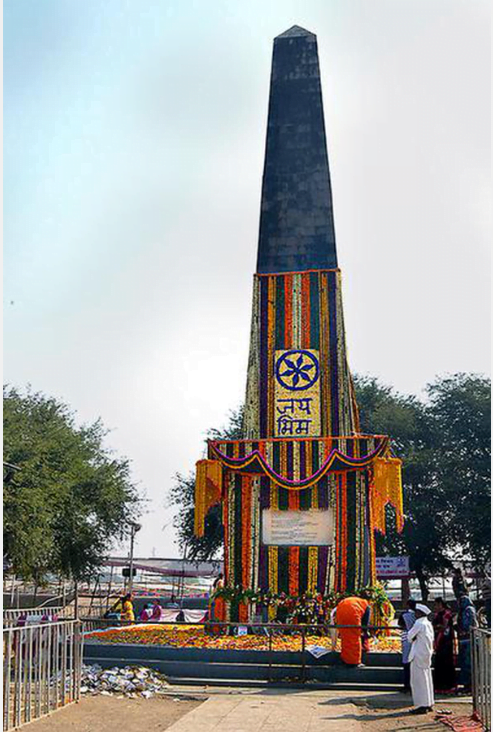History and Art and Culture
Context:
- The 205th anniversary of the Bhima-Koregaon battle passed without incident as lakhs of Ambedkarites from across Maharashtra and the country congregated near the Ranstambh (victory pillar) in Perne village in Pune district on Sunday under heavy security cover.
- Keeping an ever-vigilant eye to avoid any recrudescence of the violence during the bicentenary celebrations of the battle in 2018, the Pune Rural Police strictly monitored social media, deleting over 100 posts found to contain provocative content with the possible aim of rupturing peace.
- This is in view to avoid violence as manifested in 2018 clashes.
About the battle:

- Bhima-Koregaon is a small village in Pune district of Maharashtra
- On January 1, 1818, a Dalit-dominated British Army had defeated a Peshwa army, led by Peshwa Bajirao II, in Koregaon.
- The British, with just 834 infantrymen — about 500 of them from the Mahar community — and 12 officers defeated the 28,000-strong army of Peshwa Bajirao II.
- It was one of the last battles of the Third Anglo-Maratha War, which ended the Peshwa domination.
- The battle attained a legendary stature for Dalits, who consider the win as a victory of the Mahars against the injustices perpetuated by the Peshwas.
- A pillar, known as Vijay Sthamb (victory pillar), was installed by the East India Company in memory of those who fought for them in the battle. It is at this pillar that thousands of Dalits come to pay respect every year on January 1.
Who Were the Mahars?
- Historically, Mahars were considered untouchables.
- But the nature of their work, often in administration or military roles, situated them with upper castes quite regularly
- Maratha King Shivaji recruited a number of Mahars into the Maratha army in the 17th century. The Mahar men often served as guards or soldiers.
- Mahar community even fought alongside Peshwa forces in many battles, including the third battle of Panipat.
- However, relations between the Mahars and Peshwas turned sour after Baji Rao II reportedly insulted the community by rejecting their offer to join and serve in his army.
Significance of the battle:
- In 1928, B. R. Ambedkar had led the first commemoration ceremony. Since then, every year on January 1, Ambedkarites gather at Bhima Koregaon to celebrate their victory against the upper caste Peshwa regime of the Maratha Empire, whom they see as their oppressors.
- Mahar Dalits faced several injustices under the Peshwa rule.
- This victory, therefore, was significant for the Dalits who had been marginalised and oppressed for so long.
- It provides a rallying point and an assertion of pride for Mahar community.
- It was a fight against untouchability, and for self-respect and equality.
- The victory had become “a voice of identity for the downtrodden”.
Controversy and challenges:
- The annual celebrations in 2018 were marred by violence leading to death of one person and injuries to several others.
- Police investigation into the incident led to the arrest of several activists who they alleged had “Maoist links”.
- The police alleged that they funded the Elgar Parishad meeting on December 31, 2017, where inflammatory speeches were made, according to police, leading to the violence.
- The 2018 clashes heightened social tensions across the State and resulted in massive destruction of property belonging to Ambedkarite members.
- Since then, Ambedkarite outfits have accused the State police of dragging their feet over investigations into the clashes
- Outfits like the Pune-based Republican Yuva Morcha (RYM) have charged the former BJP regime of shielding the alleged perpetrators of the violence, including radical Hindutva leaders Milind Ekbote and Sambhaji Bhide.
- Several arrests were made in case Pune Police arrested Surendra Gadling, Sudhir Dhawale, Rona Wilson, Shoma Sen and Mahesh Raut with alleged Maoist links for inciting violence. Later on, a few more were arrested, including activists Varavara Rao, lawyer Sudha Bhardwaj and activists Arun Ferreira and Gautam Navlakha
- There is concern of politicisation of Dalits against Hindutva, particularly after the Una violence in Gujarat.
Way forward:
- History has been, and still is, twisted by vested interests to exploit, existing or imaginary, fault lines within the Indian society.
- However, the Bhima-Koregaon Ranstambh Seva Sangh (BKRSS) is regarded as a site of positive memory of Dalit’s valour and a symbol of their renewed political aspiration.
Source The hindu













